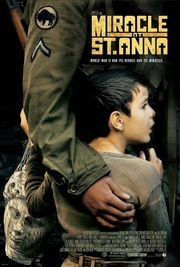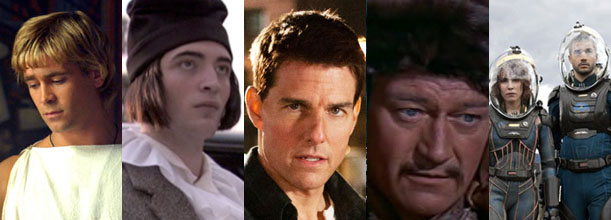Miracle at St. Anna

The director of Do The Right Thing (and future ruiner of Oldboy) doesn’t get to quietly sneak great films past us. Especially ones with JOSEPH GORDON-SODDING-LEVITT in them. Only for five minutes, but he still has words to say and everything. But then, Miracle at St Anna is not a great film. It’s not even particularly alright.
Hector Negron (oi, stop it you) is an aging Puerto Rican postal clerk who one day, apparently unprovoked, shoots a customer with a WW2 German Luger which he’s somehow been sneaking into work every day. When his apartment is searched, someone finds a ruddy great white statue head (which has been missing since that war that this film is about). We then get a COLOSSAL flashback to young Hector and his three black soldier friends, as they march, fight, possibly do magic, annoy some Italians, live, learn and love. Stick around and you might just learn summin’ yerself, though I doubt it; Miracle at St Anna is an overlong, tedious misfire.
Unfortunately, pretty much all the blame lies at Spike Lee’s feet. His first foray into war is a clichéd, muddled, overstuffed mess of a film, whose minor triumphs are overwhelmed by its countless problems. Lee is completely out of his depth here, and nowhere is this more obvious than during the immensely flat battle sequences. Shots drag when they should zip, the camera angles and movement are strange and distracting; it’s just hopeless. And that’s not all! A pair of scissors (or, y’know.. Avid) would have done well to make friends with the ridiculous 160 minute runtime, particularly the almost event-free second hour. Saying this, Terence Blanchard’s score somehow manages to fill every frame with cloying sentimentality and manipulation. Have we not, as a species, learnt how to feel emotion without music cues? If we have, nobody told these guys.

Spike’s always been vocal about poor depictions of black characters in films made by white directors, but he’s no better when it comes to racial stereotyping; all the Italian characters seem one second away from dashing off to rescue Princess Peach, the Nazis may as well goosestep everywhere they go, and the rednecks appear to be biding their time in between lynchings. It’s a shame, as Spike has an important point to make about how undervalued black soldiers were during the war; in one scene, a white officer accidentally fires artillery at a division of ‘Buffalo Soldiers’ because he refuses to believe that they could have advanced that far. But the message is drowned in a murder mystery that isn’t mysterious, a love story so slight it may not actually be intentional and a script so exposition-heavy it could be a text book. Go back to what you know, Spike.
One last thing; like everyone else who’s seen this film, I’m buggered if I can tell you what the titular miracle is. A radio stops a bullet at one point, and one soldier looks like a sacred hill, apparently, but that’s the best I can offer.





Recent Comments